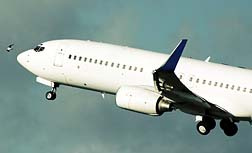 Thankfully this time, there were no deaths—and unlike the Potomac disaster of 1982 that was credited to pilot error, in this case the pilot of US Airways Flight 1549 is being hailed as a hero for avoiding the densely populated areas of the city and setting the plane down in the Hudson. Pilot Chesley B. "Sully" Sullenberger III, 57, is described as being both 'talented and charmed' in managing to set the plane down as he did, without death and few injuries.
Thankfully this time, there were no deaths—and unlike the Potomac disaster of 1982 that was credited to pilot error, in this case the pilot of US Airways Flight 1549 is being hailed as a hero for avoiding the densely populated areas of the city and setting the plane down in the Hudson. Pilot Chesley B. "Sully" Sullenberger III, 57, is described as being both 'talented and charmed' in managing to set the plane down as he did, without death and few injuries.There appeared to be other factors working that added up to what may are describing as a miracle. The Airbus A320 was only a minute or two from takeoff, so it hadn't achieved maximum altitude when the plane's two engines suddenly, and inexplicably failed. The pilot was able to guide the massive plane carrying 150 passengers into a gliding splashdown into the river, much like a floatplane landing.
Only harder. Floatplanes have pontoons and structures to help dampen the forces of hitting water at high speeds. And even so, if you've ever been in a floatplane you know when you've hit the water. It feels hard—because water is as hard as pavement when you hit at high rates of speed. Thus, the landing for the passengers of Flight 1549 would have been anything but routine, and the impact—even on water—would have felt akin to slamming into the ground.
Flight 1549, with 150 passengers and a crew of five, took off from La Guardia airport bound for Charlotte, North Carolina when, at 3,200 feet the Airbus A320 lost power in both engines. Realizing he could not return to the airport, the pilot made the decision to ditch the aircraft in the Hudson.
Superlatives all relating to the 'miracle' theme abound. The pilot avoided buildings. There were no other watercraft in front of the plane when it set down on the Hudson. The plane did not break up, and it did not sink. No one died. In fact, most of the passengers walked out of the stricken aircraft onto waiting ferries for the cold hop back to shore, under their own power.
However, concerns remain. Why did the engines abruptly fail? And why both engines? Speculation remains that the Airbus 320 flew into a flock of birds, and as jet engines and birds do not mix, it might explain why both engines failed—assuming the flock of birds was large enough to envelope both engines.
But could there have been another factor, such as the failure of a mechanical, hydraulic or electric malfunction that might have affected both engines? And if birds were an issue, why haven't aircraft manufacturers solved that problem, by somehow shielding, or protecting the intake of jet engines from such an occurrence?
In the case of Air Florida Flight 90, the stricken Boeing 737 that slammed into the Potomac on January 13th 1992, the National Transportation Safety Board (NTSB) ruled that the accident was caused by pilot error. The pilots apparently had failed to switch on the engine's anti-icing equipment, had used reverse thrust in a snow storm prior to take off, and had failed to abort the takeoff as required by regulations observed by the Federal Aviation Administration (FAA). A total of 78 people died in that plane crash, including four motorists on the 14th Street Bridge, after their cars were crush by the plane.
For now, the pilot is being hailed as a hero. But quite properly, every aspect of US Airways Flight 1549 will be gone over with a fine-tooth comb by the NTSB. Maintenance records, weather, the actions of the crew on the flight deck before, during and after take-off will all be a factor.
Early in the flight the pilot radioed the control tower on Long Island that the plane had sustained a 'double bird strike,' suggesting both engines were affected. Thus, a bird strike is the primary working theory at moment.
However, the New York Times reported this morning that FAA records indicate that the particular Airbus A320 involved in the plane crash yesterday had made two previous emergency landings since 2000. This first occurred on February 2nd 2002, when pilots on the flight deck spotted flames in the left engine. Eighteen months later, the same plane made an emergency landing after indicators warned about problems with a landing gear. A subsequent inspection found that the warning had proven false.
READ MORE PLANE CRASH LEGAL NEWS
Yes, miracles do happen and there will be many aspects of the plane crash into the Hudson River yesterday that will be described as such. But questions remain, and they need answering. US Airways, and the air industry may have dodged a bullet yesterday. But they may not, next time. And passengers who survived, but who were severely frightened could be in for some long-lasting emotional trauma. They would be forgiven for seeking compensation, through legal means, in an effort to help pay for medical bills, counseling, or for any aspect of their lives that may have changed as a result of this plane crash, miraculous as it might have been.
